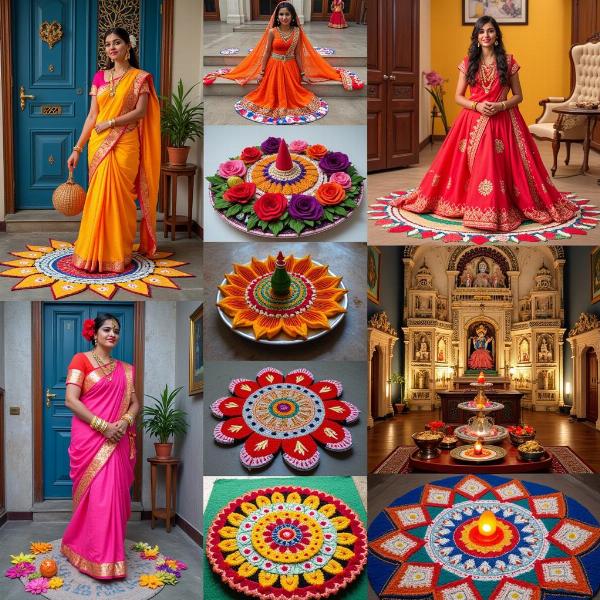Varnika, a name resonant with beauty and color, holds a special place in Indian culture. Understanding the true “varnika meaning in Hindi” goes beyond a simple dictionary definition. It involves exploring its rich etymology, cultural significance, and the emotions it evokes. This article delves into the multifaceted nature of “varnika,” providing a comprehensive understanding of its meaning and usage.
Decoding “Varnika”: A Deep Dive into its Meaning
The word “varnika” (वर्णिका) in Hindi primarily refers to “color” or “hue.” It’s derived from the Sanskrit word “varna,” which also signifies color, caste, or category. However, “varnika” carries a deeper connotation, often associated with vibrancy, beauty, and the artistic representation of color. Think of the vibrant “varnika” of a peacock’s feathers or the delicate “varnika” of a flower petal. These examples highlight the word’s connection to natural beauty and artistic expression. The “varnika meaning in Hindi” can also extend to describing complexion, particularly in literature and poetry. So, when you encounter “varnika,” consider the context to grasp its precise meaning.
Varnika in Indian Culture and Traditions
“Varnika” plays a significant role in various aspects of Indian culture. From traditional clothing to religious ceremonies, color holds a symbolic meaning. In Hinduism, specific “varnikas” are associated with different deities and festivals. For instance, red symbolizes power and is associated with Goddess Durga, while yellow represents knowledge and is linked to Lord Vishnu. During festivals like Holi, the vibrant “varnikas” signify joy, unity, and the triumph of good over evil. Understanding the cultural context of “varnika” allows for a richer appreciation of its significance in Indian traditions.
Beyond the Basics: Exploring the Nuances of Varnika
“Varnika” isn’t just a descriptive term; it’s a word imbued with emotional and symbolic weight. In literature and poetry, “varnika” is often used to evoke a sense of beauty, emotion, and even spirituality. Think of the descriptions of a heroine’s “varnika” or the “varnika” of a sunset – these descriptions paint vivid pictures in the reader’s mind. The word’s ability to transcend its literal meaning makes it a powerful tool for artistic expression.
 Varnika in Indian Art and Culture
Varnika in Indian Art and Culture
Varnika and Personal Identity: A Reflection of Self
In some contexts, “varnika” can also relate to an individual’s character or personality. While the direct connection to the caste system is outdated and should be avoided, the concept of “varnika” can still be interpreted as a symbolic representation of one’s inner qualities. This interpretation emphasizes the richness and complexity of human nature.
Varnika in Modern Usage
How is “varnika” used in everyday conversations today? While it might not be as commonly used as simpler terms for color, it still holds a place in formal settings, literary works, and discussions about art and culture. Understanding its nuanced meaning allows for more precise and expressive communication.
Conclusion: Appreciating the Depth of Varnika
From its etymological roots to its cultural significance and modern usage, “varnika” is more than just a word for color. It’s a concept that embodies vibrancy, beauty, and the rich tapestry of Indian culture. Understanding the “varnika meaning in Hindi” allows for a deeper appreciation of the language and the cultural nuances it encapsulates. So, the next time you encounter “varnika,” remember the multifaceted meaning it holds and the stories it tells.
FAQ:
- What is the most common meaning of “varnika” in Hindi? The most common meaning of “varnika” is color or hue.
- How is “varnika” used in Indian culture? “Varnika” is used symbolically in Indian culture, representing different deities, emotions, and festivals.
- Is “varnika” still used in modern Hindi? While less common than simpler terms for color, “varnika” is still used in formal settings and artistic expressions.
- What is the connection between “varnika” and “varna”? “Varnika” is derived from the Sanskrit word “varna,” which also means color.
- How can I use “varnika” correctly in a sentence? Use “varnika” to describe color in a more nuanced or artistic context.
Meaning-Hindi.in offers expert translation services specializing in Hindi and various other languages. We cover a wide range of services, from business and legal document translation to website localization and technical manual translation. Our team of experienced translators ensures accuracy and cultural sensitivity in every project. Whether you need quick translation services or specialized industry expertise, Meaning-Hindi.in is your one-stop solution. Contact us today at [email protected] or call us at +91 11-4502-7584. Let Meaning-Hindi.in bridge the language gap for you.